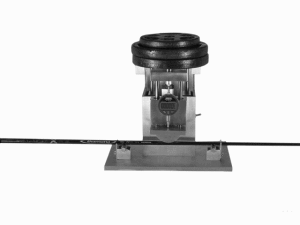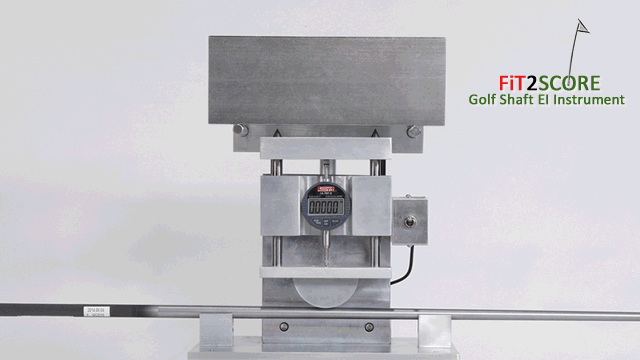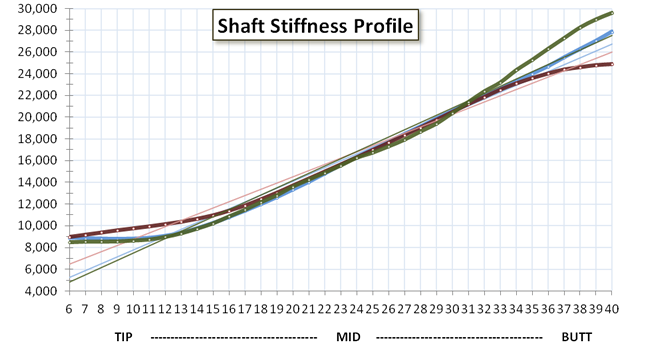EI SHAFT PROFILING
By Russ Ryden, Fit2Score, A Dallas Fort Worth Club Fitter & Club Maker
The Golf Center at the Highlands, Carrollton Texas
If you want to understand golf shafts the way a golf shaft engineer understands the, you need to see the three point EI profiles of the linear strength of the golf shaft. The term, EI is engineering short hand for E= Modulus of Elasticity and I = Area Moment of Inertia. Or, more simply, the elasticity of the shaft material and the thickness of the cross section of the shaft. The combination of these combine into the stiffness of the shaft at any point on the shaft. If the walls are thicker that section the shaft is stiffer. If the graphite strands are running from butt to tip the stiffness they give to the shaft is more than if they are angled to control torque.
Simple marketing terms, high mid or low kick point are just that. The marketing department of the shaft companies attempt to give the golfing public easy terms to understand. In today’s world of elaborate shaft design and fabrication, only three point EI profiling can reveal the linear bend character of the golf shaft. Detailed EI profiles, like the ones seen here can show how the shaft bends under load. That information, simply stated, is the functional knowledge of the golf shaft needed for golf club fitting.
A few years ago, when I was introduced to the concept of three point EI measurement, there was no generally available instrument. Mark Timmes had had one designed and built at Hot Stix. I believe that instrument is now owned by Mizuno. Don Johnson a fellow club builder designed a home made instrument and my friend and mentor Dave Tutelman also made a simple version. A laboratory quality computer controlled hydraulic instrument starts around $10K.
 I set out to build an instrument that used gravity in the form of a stack of weights, and some form of powered assistance to raise and lower them. Along the way, I had a long and expensive encounter with friction. About a year after I started, fifteen of these were made. The original owners were mostly club fitters, many of my instruments are have now been purchased by golf shaft companies. Because it was designed specifically for the golf shaft, It does a better job of measuring a golf shaft than the computer controlled hydraulic instruments.
I set out to build an instrument that used gravity in the form of a stack of weights, and some form of powered assistance to raise and lower them. Along the way, I had a long and expensive encounter with friction. About a year after I started, fifteen of these were made. The original owners were mostly club fitters, many of my instruments are have now been purchased by golf shaft companies. Because it was designed specifically for the golf shaft, It does a better job of measuring a golf shaft than the computer controlled hydraulic instruments.
A few weeks before the C-Taper Lite released, I caught up with Kim Braly at the PGA Tour Crowne Plaza Invitational at Colonial tournament. This is an outtake from that interview. We talk about EI profiling.
The engineering principal is not new. A beam has two properties that affect deflection. The stiffness of the material and the cross sectional area of the beam. EI charts for building components are available to help building engineers know how much a support beam will bend under the weight of the building place on it. Golf shafts are not much different to a shaft design engineer. The material, steel or carbon fiber, has known load bearing properties. The cross sectional area is the walls of the shaft. In carbon fiber design, the beam stiffness is affected by the direction of the fiber. When the fiber runs from tip to butt, all if its strength is applied to the stiffness of the shaft. When the fiber is oriented at an angle to control radial stiffness which we call torque, some percentage of the tip to butt strength is lost. Knowing these material properties, a bend design is translated from material strength into wall thickness and a shaft layup is forecast by design software.
A three point EI instrument validates the prototype shaft design. In the hands of a club fitter, it decodes the design into bend profiles. A golf shaft, in its simplest terms is weight, EI profile and GJ profile. We can add another property, feel, which is affected by material. And perhaps yet another, elasticity, again a material property. But at the top of the list for understand the modern golf shaft is EI and GJ.
To measure EI a shaft is supported at two points. A weight is placed in the center and the deflection is measured. This deflection is transformed into EI by factoring the weight of the load, length of the beam and the amount of the deflection. We measure every inch from 6″ from the tip to 6″ from the butt. The charts show the first reading at 6″, but this point includes 5″ below and 5″ above this point. The flex on the graphs shows the stiffness all the way to the tip of the shaft. The numbers are smoothed to remove measurement ‘noise’.
I like to tell the story about my first meeting with Tim Gillis, who was then the Director of Sales at Miyazaki Golf Shafts. I stated that I had close to 1000 shafts profiled. He smiled and said, ‘We have been doing this for years, our database is over 5000’. Three point EI is the measuring standard used by all of the major shaft companies to design and validate golf shafts.
This site is about shafts from the point of view of the shaft designer, all measured with a consistent and uniform methodology. The group of fitters that writes the reviews here are among the first to fit with a completer EI/GJ understanding of the shafts they use.
When I started the project of designing an EI instrument, I looked at the work of Dave Tutelman. Dave documented the design of a simple device, EI Machine to Profile Golf Shafts. Through Dave I became friends with Don Johnson, Don also created an EI measuring instrument years ago. The exchange of ideas with Dave and Don guided the development of the three point EI instrument illustrated here. After several years of experience I designed and manufactured an improved design. The measurements are so good, the software no longer needs to smooth out the data.
When questions about shaft ovaling and overhanging weight affecting the readings on my instrument arose, Dave studied the issue. He concluded in Errors in EI Measurement due to Shaft Weight that it was not a significant source of error because I applied a preload to the shaft. I have measured ovaling at the butt of the shafts and found what little could be measured was within the measurement error seen in repeat readings. The numbers being discussed here are ten thousands of an inch.



